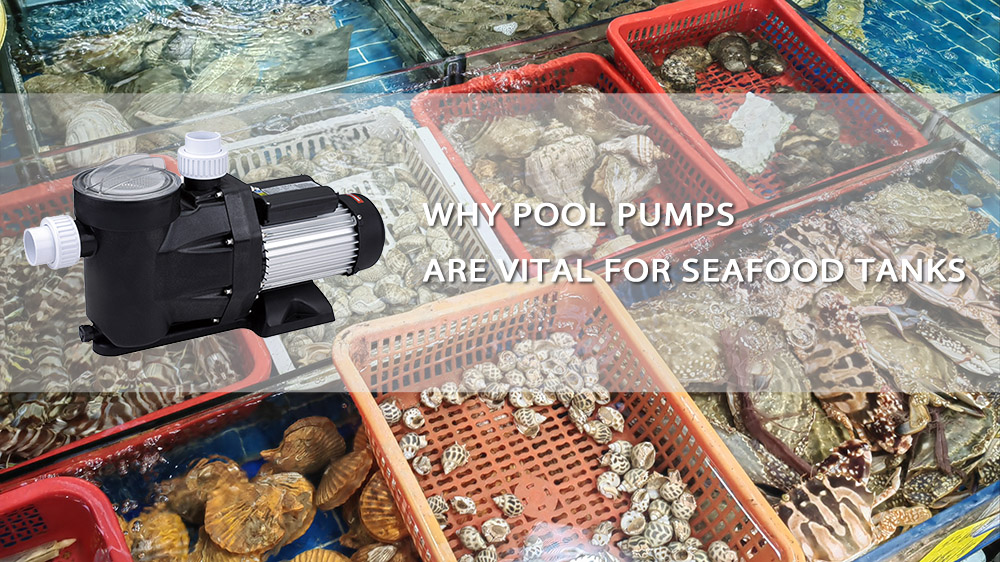+86 13816508465
Pump Knowledge
Apr. 24, 2025

Seafood holds a special place in my heart as both a culinary delight and a cultural experience. I've always cherished visiting bustling seafood markets to handpick the freshest catches, admiring how vendors maintain their vibrant aquariums. During one such visit, I noticed something unexpected yet fascinating – commercial-grade water pumps, identical to those used in swimming pools, humming beneath the seafood tanks. This discovery sparked my curiosity: Why would pool pump technology be critical for maintaining seafood ecosystems? Join me as I dive into the science behind water circulation systems and their vital role in preserving marine life vitality within commercial seafood tanks.
Pool pumps serve three core functions in seafood markets:
Water Circulation: Stagnant water fosters bacterial growth and oxygen depletion, endangering marine life. Pool pumps ensure continuous water movement, mimicking natural aquatic environments and keeping organisms healthy.
Filtration: Integrated filters remove debris, waste, and harmful particles, maintaining water clarity and quality. High-capacity pre-filters, for instance, are critical for trapping contaminants in tanks housing sensitive species like lobsters or crabs.
Oxygenation: By agitating water surfaces, pumps improve oxygen exchange, vital for the survival of high-density seafood stocks.
Choosing the Right Pool Pump: Key Considerations
Selecting a pump tailored to your seafood tanks requires evaluating these factors:
1. Flow Rate & Head :
Match the pump's flow rate (e.g., 14–50 m³/h for medium to large systems) to your tank's volume.
Ensure adequate head (e.g., 10–15 meters) to overcome vertical lift and pipe resistance.
2. Durability & Corrosion Resistance:
Opt for corrosion-resistant materials like fiberglass-reinforced plastic or engineering plastics to withstand prolonged saltwater exposure.
Stainless steel shafts and reinforced impellers enhance longevity in harsh environments.
3. Energy Efficiency:
Prioritize pumps with IE4-grade or higher motors, which reduce energy consumption by up to 30% compared to older models, aligning with sustainability goals.
4. Noise Levels:
Low-noise designs with vibration-dampening technology are essential in busy markets to avoid disrupting customers.
Troubleshooting Common Pool Pump Issues
Even robust systems encounter problems. Here’s how to address them:
1. Low Water Flow:
Causes: Clogged filters, blocked pipes, or air leaks in suction lines.
Solutions: Clean filters, inspect pipes for obstructions and tighten connections.
2. Excessive Vibration or Noise:
Causes: Loose mounting bolts, misaligned motor pump shafts, or worn bearings.
Solutions: Tighten bolts, realign shafts, or replace bearings.
3. Motor Overheating:
Causes: Voltage fluctuations, poor ventilation, or blocked cooling systems.
Solutions: Ensure a stable power supply, improve airflow, and clear debris around the motor.
4. Leakage:
Causes: Damaged seals or gaskets.
Solutions: Replace mechanical seals and inspect gaskets regularly.
Maintenance Tips for Long-Term Performance
Proactive care extends pump lifespan and prevents downtime:
1. Daily Checks:
Monitor water flow and filter pressure. Clean filters if pressure rises significantly above normal levels.
Inspect for leaks or unusual noises.
2. Monthly Maintenance:
Lubricate bearings with high-quality, waterproof grease.
Verify electrical connections and voltage stability to prevent motor burnout.
3. Seasonal Overhauls:
Drain and clean pumps during prolonged inactivity to prevent corrosion.
Replace worn components like impellers or seals before peak seasons.
Conclusion
Pool pumps are the unsung heroes of seafood markets, ensuring optimal water quality and marine health. By selecting pumps based on flow rate, durability, and energy efficiency, addressing issues promptly, and adhering to maintenance routines, businesses can reduce operational costs and enhance product vitality. Modern advancements, such as IE4-certified motors and corrosion-resistant designs, offer seafood vendors reliable solutions tailored to demanding aquaculture environments.
Explore Further: Consult suppliers for pumps with integrated filtration systems or modular designs that simplify customization based on tank size and species requirements.
Address
No.17 XeDa Jimei Ind. Park, Xiqing Economic Development Area, Tianjin, China
Telephone
+86 13816508465
QUICK LINKS